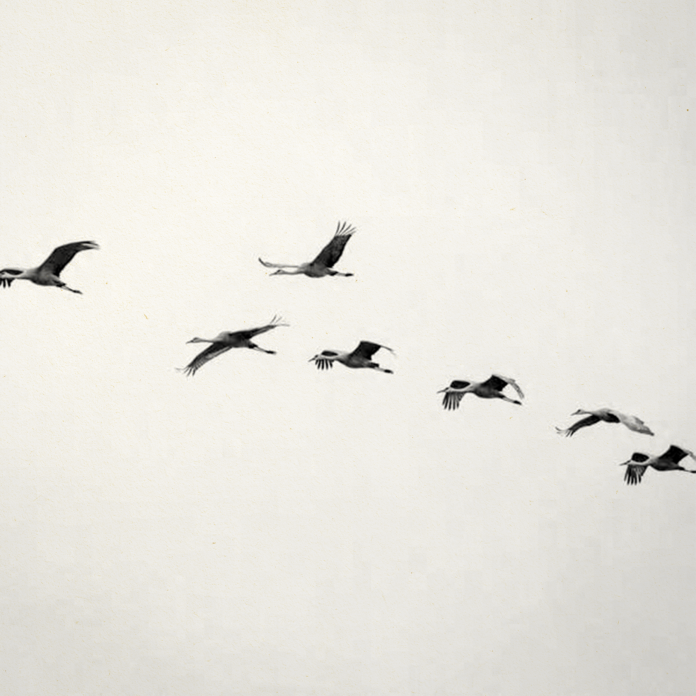In the fields of Schildow, fifty kilometers north of Berlin, Sepp and I study the sky, searching for words. On this cloudy October afternoon, almost two kilometers above us, the heavens are filled with soaring Vs—thousands upon thousands of cranes heading south. Majestic birds, with tri-colored crowns, four feet in height, a wingspan of eight, mere specks.
Their flight patterns had inspired alphabets, Mercury said to have created the Roman one as he watched them. Evolved over the fifty-five million years they have been on Earth, cranes have a language of their own with over twenty vocalizations: purring for maintaining contact, squawking for courting and coordinating groups, trumpeting for alarms; not to mention bugle calls, moans, hisses, honks, whistles, and snoring. Homer’s Iliad mentioned their “shriek over the streams of Okeanos,” likening them to Agamemnon’s army.
Uncomfortable with the military reference that reminds me of Sepp’s Saxon warrior roots, I think instead of our old form of communication, willy-nilly insertions of English words like Smalltalk into German, fusing two languages that split from each other two thousand years ago. Denglish, it’s called today, a no-rule hybrid that lends itself to absurd creations like Blumenkohl-Zungen Bench to refer to the seat where Sepp claimed to have developed a cauliflower tongue following our teenage hours of making out. Sweethearts in the early sixties, a misunderstanding had sent us on different pathways. Reconnecting through Facebook fifty years later, we struggle now to breach the silence of our post-War childhood and finally to speak of the conflict that found our countries on opposite sides. But just as cranes honk on long flights, we reserve the pure form of our native tongues for serious topics.
As we had done that morning at Berlin’s museum of the Topography of Terrors: The Historic Site 1933-1945, where we faced head-on events that Sepp’s renowned classmate, W.G. Sebald, said should only be approached obliquely. Captured in two by three foot black and white photos: Jews, gypsies, and those with alternative lifestyles being carted off to the camps. “Sheisse,” Sepp said, continuing in German to explain that his son who lives in a camper might have ended up in prison. It seems the right time to bring up my mischling daughters, but I don’t. Is it the language of the former enemy or his potential shock that holds me back? Unsure. Only outside the museum, after we’d gone our separate ways through the rolling coffin maze, a grid of 2,711 unmarked concrete slabs — Eisenmann’s Memorial to the Murdered Jews of Europe — does Sepp switch to English: “Quite an effect those little hills.” I find no words.
Perhaps, we would do better to stick with mostly non-verbal communication like the cranes’ courtship dance which consists of hopping, pirouetting, and throwing bits of grass, combined with occasional squawking. A Smalltalk form of foreplay that, while not part of the usual German lexicon that stresses getting right to the point, Sepp had once emulated, creating a game of flicking and catching beer coasters at a romantic dinner.
“Wir Deutschen out do you Americans in the Wortschatz department,” he added. “For certain activities we have over two hundred words: bumsen, aufhacken…” He’s on to the third before I realize he’s talking about sex. If he were to venture now to the cranes’ breeding site in the wetlands beside the Schildow fields, we might witness their dance, but he shows no inclination. Instead, we stand like tin soldiers three meters apart, watching the swirling, often intersecting ellipses of the overhead birds, wondering if their migratory routes are determined by parental lessons—solo navigation guided by stars, sun, or the Earth’s magnetic field—or just by their innate sense of distance and direction. Whatever the method, they fly with ease over any barrier, constantly communicating to keep together.
We appear to be stationed underneath a critical junction for the sedge, the cranes’ two main paths now diverging in a gray sky, one veering right towards France and Spain, the other left to Turkey and Israel, the Western and Eastern European flyways. In the center, the lesser used Baltic route that courses over Poland, Serbia, and Italy towards Africa, I think of as Denglisch, a middle road we might travel.
But this afternoon, as if following the cranes’ diverging paths, Sepp looks east and I, west, finding no words in any language, as if anticipating that at the day’s end we will once again take a different flyway.

